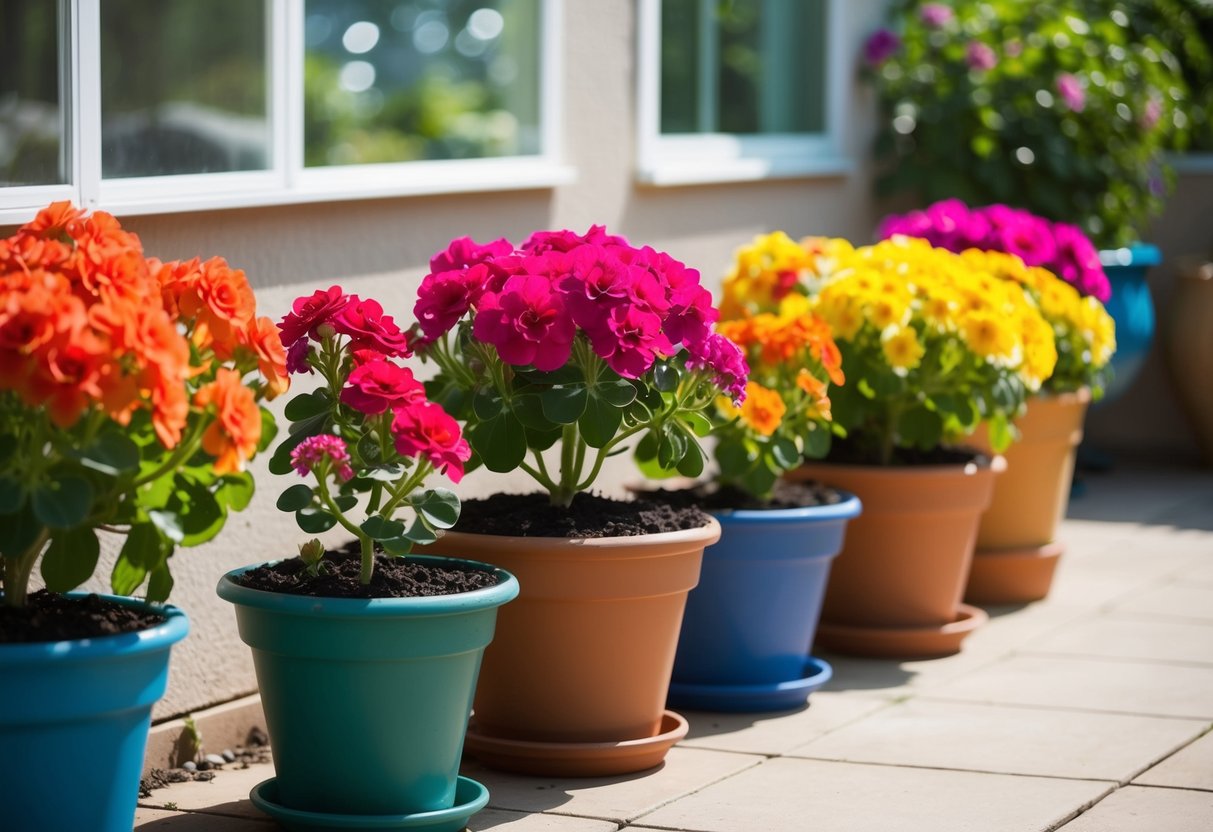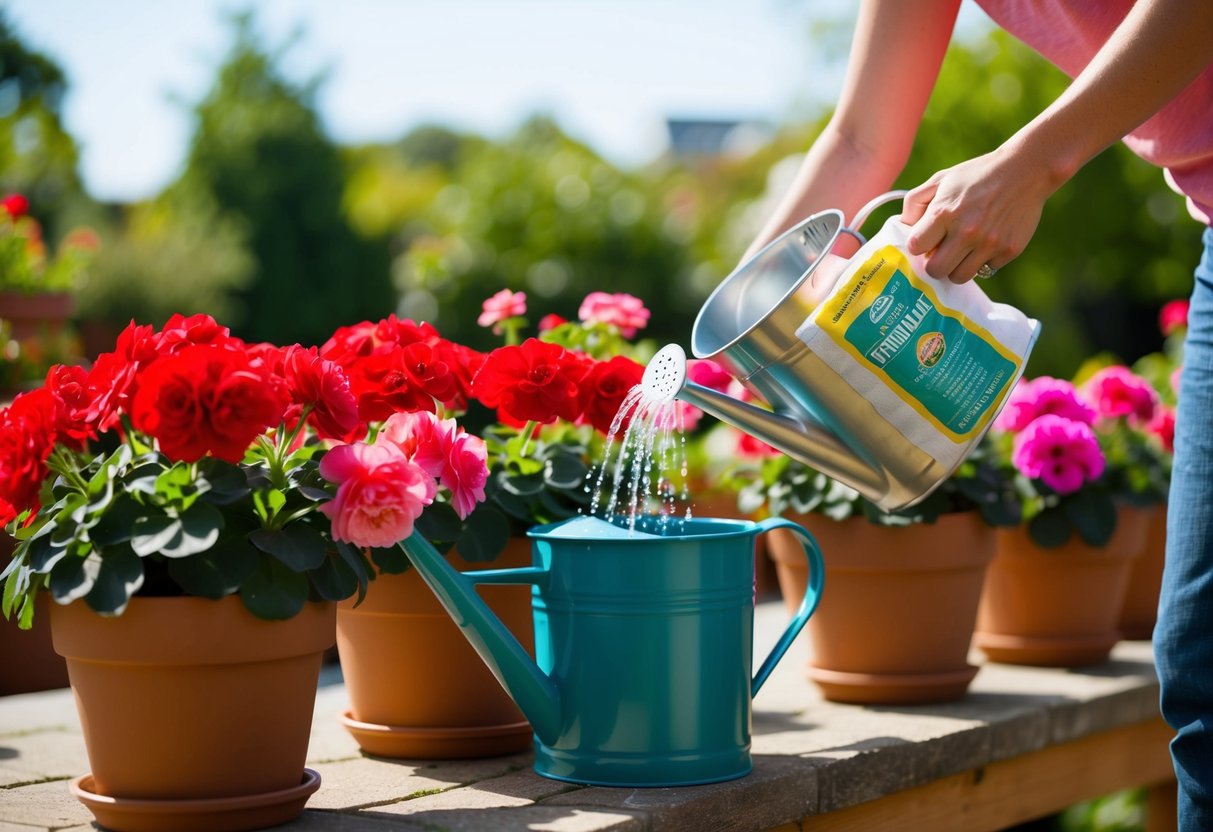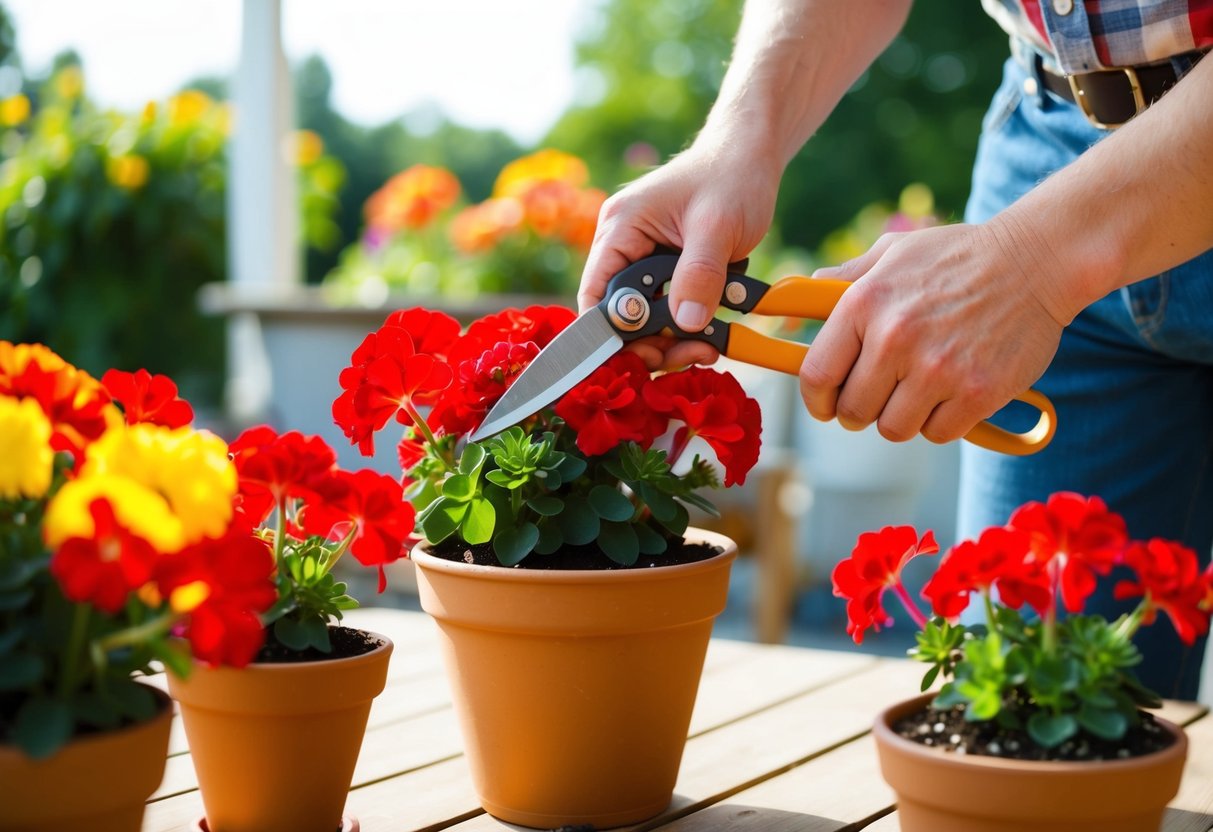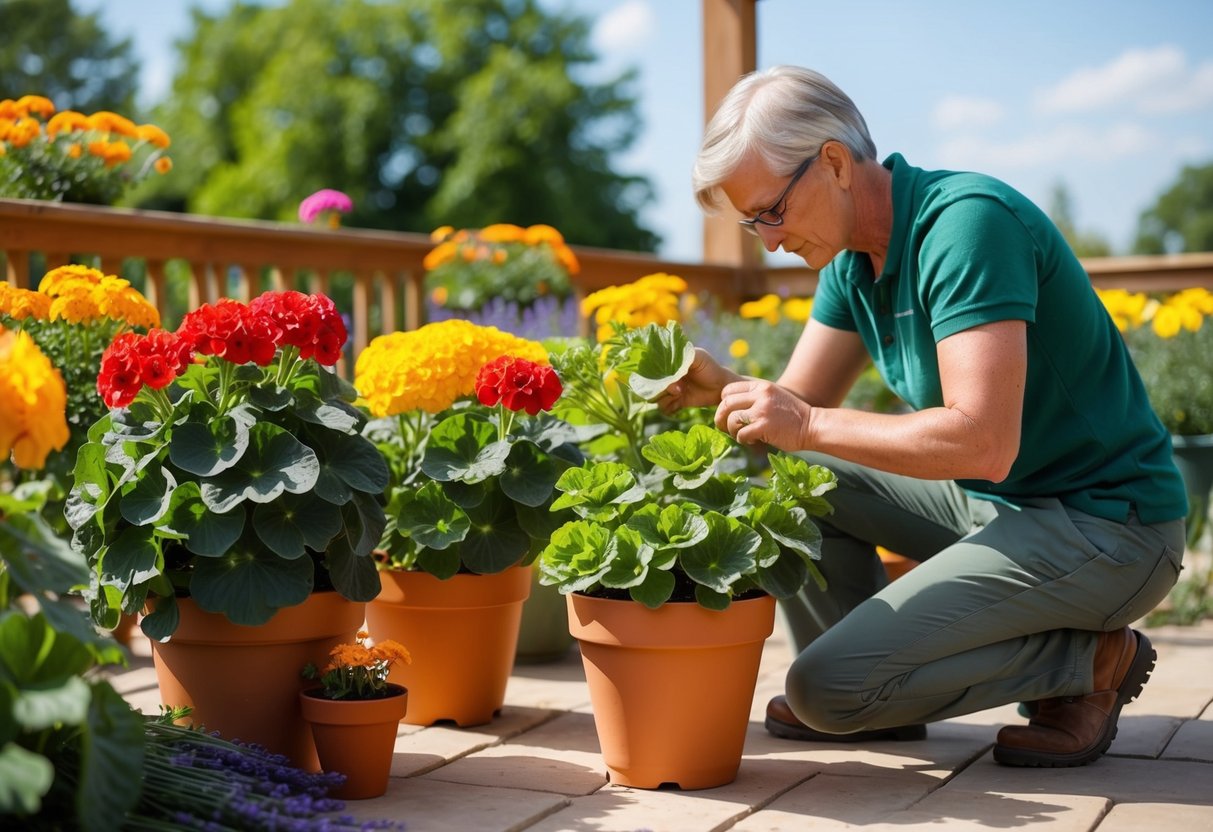How to Care for Geraniums in Pots Outside: Essential Tips for Vibrant Blooms
If you want your outdoor space to pop with color, potted geraniums are a great choice. With their vibrant blooms and lush foliage, geraniums can brighten any patio or garden.
To care for geraniums in pots outside, ensure they have well-draining soil and water them 1-2 times a week. It’s important to keep them in temperatures between 65°F and 75°F to help them thrive.

A sunny spot out of direct sunlight will be ideal for your potted geraniums. You’ll find that they are not only easy to care for but also quite forgiving.
Don’t forget that choosing the right pot size matters too—a pot with room for roots to spread will ensure healthy growth. Using a well-balanced plant feed can support their growth and vibrant blooms.
Overwatering can lead to root rot, so be sure to let the soil dry a bit before watering again. If roots start to rot, trim away the dark, mushy parts to keep your plant healthy. With just a bit of attention, your geraniums can flourish, making your outdoor area a vibrant haven.
Selecting the Right Pot and Soil for Geraniums

When growing geraniums in pots, choosing the right pot and soil is crucial. Your plants need a pot with good drainage and soil that supports healthy growth.
Choosing the Best Pots for Geraniums
When picking a pot for your geraniums, size and drainage are key.
Select a pot that provides enough space for roots to grow but isn’t too large. This helps control the moisture level, preventing root rot. Look for pots with drainage holes at the bottom. This ensures excess water can escape, keeping the soil from becoming waterlogged.
Materials like clay or terracotta are ideal because they allow air flow, helping to keep the roots healthy.
An appropriately sized pot with good drainage will support your geraniums’ needs.
Understanding Soil Needs for Healthy Geraniums
Geraniums thrive in well-draining soil. Use soil with good drainage to prevent water from sitting around the roots. A soil mix with sand, perlite, or small rocks will help.
Maintain a slightly acidic soil pH between 5.8 and 6.5 for best results. This ensures vital nutrients are available to the plants.
Adding a balanced, slow-release fertilizer during planting may enhance growth. Checking the soil moisture regularly and adjusting watering times will keep your geraniums healthy and vibrant. Consider testing the pH to ensure your soil meets the ideal conditions for your geraniums.
Planting and Positioning Geraniums

When planting geraniums in pots outside, it’s important to choose the right container and position them correctly for sunlight and air circulation. Geraniums thrive with proper spacing and the right conditions to bloom beautifully.
Planting Geraniums in Pots
Start by selecting a pot with good drainage. Geraniums dislike soggy soil, so make sure there are enough drainage holes at the bottom. Use a well-draining potting mix to avoid root rot.
Choose a container size that gives the roots enough room to grow but not too large, as this may encourage overwatering.
When placing the geranium in the pot, the top of the root ball should be level with the surface of the soil. Gently press the soil around the plant to eliminate air pockets.
If you’re working with hanging baskets or window boxes, follow the same method but ensure they are sturdy enough to support the weight of both soil and plants.
Optimal Placement for Sunlight and Air Circulation
Geraniums love sunlight. Position your pots where they can receive full sun for most of the day. Ideally, they should get at least six to eight hours of sunlight daily. This helps them bloom well and maintain vivid colors.
If the sunlight is too intense, providing light afternoon shade can help prevent scorching.
Air circulation is also key. Avoid placing pots too close to walls or other plants that might block airflow. Good circulation prevents mold and disease.
If you’re in regions with specific hardiness zones, ensure that outside temperatures remain within a safe range for geraniums to flourish. Adjust pot locations as needed with seasonal changes to maintain optimal conditions.
Watering and Feeding Potted Geraniums

Caring for potted geraniums means giving them the right water and nutrients. You need to be cautious of overwatering while ensuring they receive enough food to thrive.
Irrigation Tips for Geraniums
When it comes to watering potted geraniums, check the soil frequently. Touch it to see if it feels dry before adding water. This helps prevent overwatering, which can be harmful.
Geraniums prefer well-draining soil. Make sure the pot allows excess water to drain out easily.
Water your plants deeply once or twice a week, depending on the climate. If you notice the leaves turning yellow, it could be a sign of too much water. Adjust your watering schedule as needed.
Fertilization Practices for Vibrant Blooms
Geraniums are considered heavy feeders and need nutrients to bloom beautifully. Use a balanced fertilizer every 4-6 weeks during the growing season.
A well-balanced option ensures your plants get the essential nutrients they need.
Apply the fertilizer on slightly moist soil to prevent root burn. Always follow the package instructions for the correct amount. Fast-growing geraniums may benefit from a slightly more frequent feeding schedule. Green and healthy leaves are a sign that your plant is getting enough nutrients.
By consistently monitoring your plants and adjusting care as needed, you can enjoy vibrant blooms all season long.
Pruning and Maintenance of Geraniums

Pruning and maintenance are key to keeping your potted geraniums healthy and full of beautiful blooms. Learn how proper pruning techniques and deadheading can enhance the growth and flowering of these popular plants.
Pruning Techniques for Geraniums
To prune geraniums effectively, you want to start by cutting back the stems. Use sharp pruning shears to trim about one-third of the plant’s foliage, which helps shape the plant and encourage new growth.
It’s best to prune them in a cool, shady area to avoid stressing the plant. Regular pruning helps the plant retain a full, bushy appearance.
Geranium varieties can respond differently to pruning, so adjust your approach based on the specific type you have. Always keep your tools clean to prevent the spread of diseases.
For precise cuts, pruning shears or hand pruners are recommended. Keeping these tools sharp ensures that you don’t crush the plant material.
Deadheading for Continued Flowering
Deadheading is crucial for stimulating ongoing blooms in geraniums. This process involves removing spent flowers to redirect the plant’s energy towards producing new blooms.
To deadhead, pinch off or cut the flower stem near the base. This should be done regularly as flowers start to wilt.
You can simply use your fingers or small scissors for this task. Deadheading encourages the plant to continue producing flowers throughout the growing season, keeping your plant vibrant and attractive.
Regular maintenance through deadheading not only removes unsightly flowers but also promotes overall plant health. Be consistent with this practice to enjoy lush, continuous blooms from your geraniums.
Protecting Geraniums from Pests and Diseases

Keeping your geraniums healthy involves monitoring for pests and diseases. Watch out for spider mites and bacteria that can harm your plants. There are several methods to tackle these issues and keep your geraniums thriving.
Identifying Common Geranium Pests
Geraniums can attract various pests, with spider mites being one of the most common. They create tiny webs on the underside of leaves, which can lead to yellowing and damage.
Aphids and whiteflies are also frequent pests. These insects suck sap from the plants, weakening them over time. Inspect your geraniums regularly, especially if you notice reduced growth or a change in leaf color.
Use a strong jet of water to wash off the pests. You can also apply insecticidal soap or neem oil to keep them under control. Regular checking helps in spotting these problems early, making it easier to deal with them before they spread.
Prevention and Treatment of Geranium Diseases
Geraniums can face several diseases such as bacterial blight and Pseudomonas leaf spot. These diseases cause spotting on leaves and can lead to wilting or even plant death.
To prevent these issues, ensure good air circulation around your plants and avoid overhead watering.
Plant geraniums in well-draining soil and remove infected leaves promptly to reduce the spread. If you notice those symptoms, treat the plants with a copper-based fungicide.
It’s also wise to not reuse infected plant material for propagation.
For more details on diseases and their management, check out advice from Gardener’s Path on geranium diseases.
Regular maintenance keeps your geraniums both strong and vibrant.







